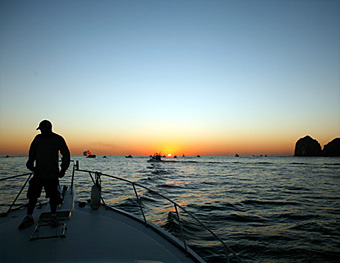
|
 |
 |
 Travel & Outdoors | January 2008 Travel & Outdoors | January 2008  
Adventure Guide to Mexico
Deep-Sea Fishing: Cabo San Lucas
 Bonnie Tsui - NYTimes Bonnie Tsui - NYTimes
go to original


| | An estimated 50,000 billfish — fast-swimming trophy fish that include marlin, swordfish and sailfish — are caught every year, and angling competitions stir up the resort strip in the fall months. | | |
In 1940, John Steinbeck embarked on an expedition to the Sea of Cortez to catalog marine life along Cabo’s rocky, undeveloped coastline, and found it “ferocious with life.” Though the town of Cabo San Lucas is now known as a luxury golf destination, it first earned its reputation through its prized access to waters teeming with fish. With the Pacific Ocean on one side and the Sea of Cortez on the other, Cabo offers exceptional sport fishing at the confluence of both in the harbor’s deep-water canyons.

The area hasn’t been nicknamed the “marlin capital of the world” for nothing. An estimated 50,000 billfish — fast-swimming trophy fish that include marlin, swordfish and sailfish — are caught every year, and angling competitions stir up the resort strip in the fall months. Sustainable tourism calls for catch-and-release practices for billfish — their populations have steeply declined over the past 50 years — though fishing operators will let you keep commonly caught game fish like yellowfin tuna, roosterfish, Spanish mackerel and dorado. On most fishing trips, the crew will clean, fillet and freeze your selected catch to take home for eating.

While the rocky intertidal zone that Steinbeck discovered in Cabo back then has been almost completely overrun by beaches and resort development, a day spent on the water captures some of that wonder. The quintessential Cabo angler experience includes chartering a small panga, or open fishing launch, early in the morning (unless you happen to be a movie star, in which case fully serviced 110-foot boats are more common). Swordfish are most plentiful January through June, as are sailfish, and the best conditions for blue and black marlin are July through November, when big storms put populations on the move. Striped marlin is caught year round.

“The fishing experience in Cabo can be unforgettable, and the marlin are the biggest challenge — they’re what people come here to catch,” said Juan Beltran, a reservations agent and dockmaster for Pisces Fleet Sportfishing. The company’s fleet ranks No. 2 in the world in the number of released striped marlin, according to the Billfish Foundation, a nonprofit organization that supports the conservation of global billfish populations. Recently, Mr. Beltran said, the tight-knit fishing community has begun lobbying the Mexican government to change its new regulations that allow midsize commercial shark fishing boats to come as close as 10 miles to shore.

Shark boats use longlines, which have about 1,000 hooks, and that method results in large incidental catches of other species, and the fishing community is advocating a return to a 50-mile distance to protect juvenile sharks and game fish populations, which are found closer to shore. “We care about our nature sources here in Cabo,” said Mr. Beltran. “They’re the source of our livelihood.”

Pisces Sportfishing, (619) 819-7983; www.piscessportfishing.com; a 28-foot boat charter is $560 a day, including crew, tackle, bait, lunch and fishing licenses for four.


Bonnie Tsui is editor of “A Leaky Tent Is a Piece of Paradise” (Sierra Club), a collection of essays on the outdoors. | 
 | |
 |



